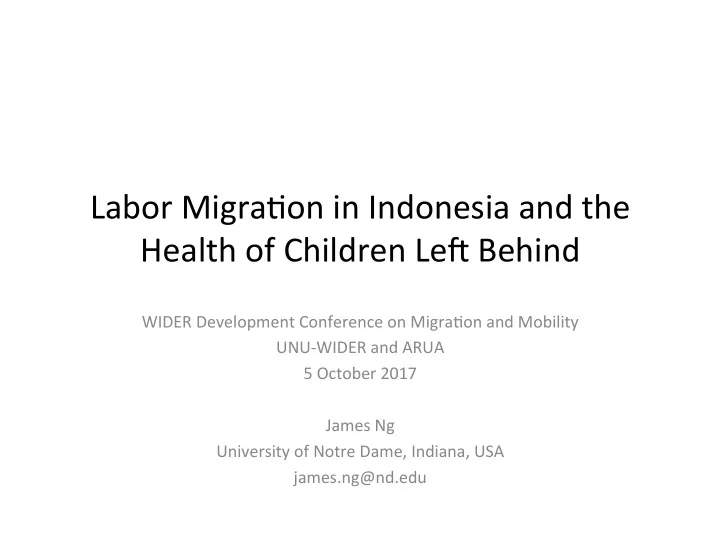

Labor Migra*on in Indonesia and the Health of Children Le6 Behind WIDER Development Conference on Migra*on and Mobility UNU-WIDER and ARUA 5 October 2017 James Ng University of Notre Dame, Indiana, USA james.ng@nd.edu
Introduc*on • Does temporary migra*on of parents for work affect the health of le6-behind children? • In Indonesia, mothers’ migra*on nega*vely affected child health • No such effect for fathers
Country background • Republic of Indonesia • Equatorial archipelago, 2 million km 2 • Popula*on 260 million, 4 th most populous • World’s 16 th largest economy • GDP: 1 trillion USD (2016) • GDP per capita: 4000 USD • Ranked 14 th among remi_ance recipients (World Bank 2015) • Remi_ances amounted to 1% of GDP
Migra*on measure • “Migrated”: moved away for the sole purpose of work • Moves are implicitly temporary in nature • Not considered in this study: – Dura*on of migra*on – Number of *mes moved and returned – Where moved to
Profile of internal migrants Source: Susan* and Damayan*, “Internal Migra*on in Indonesia: Dura*on and Factors”, 2015.
Health measure • Anthropomorphic, not self-reported • Height-for-age, weight-for-age • Standardized by age/sex group • Height-for-age Z-score (HAZ) interpreta*on: – HAZ = -1: child’s height is one SD below median child height in that age/sex group – likewise for WAZ
HAZ and WAZ • Z-score = (observed value – median value of the reference popula*on) / S.D. value of reference popula*on • Calculated using Stata module zscore06 • Advantages of using Z-scores: – linear, distance from HAZ=-2 to HAZ=-1 is the same as from HAZ=0 to HAZ=+1. – sex-independent
Sample • Children drawn from 2000 and 2007 waves of Indonesian Family Life Survey (IFLS) • In 2000: 0-7 years old • In 2007: 7-14 years old • Excluded those with HAZ or WAZ <-6 or >6 • Final sample: 2841 children, interviewed in 2000 and re-contacted in 2007
IFLS • Ongoing longitudinal household survey • Collabora*on between RAND, Universitas Gadjah Mada, and Survey METRE • Representa*ve of about 83% of the Indonesian popula*on • Five waves: 1993, 1997, 2000, 2007, 2014 • 2000 and 2007 re-contact rate: 95%
IFLS (2) • Over 30,000 individuals living in 13 of the 27 provinces
Related research • Deb and Seck (2009) examined effects of migra*on on socioeconomic outcomes including health of children in Indonesia – does not isolate effect of parental migra*on • Parental absence found to nega*vely affect child cogni*on and school a_endance in rural China (Zhang et al., 2014) and the Philippines (Poertner, 2016) • Studies on le6-behind children have tended to focus on schooling
Regression model • for child i in household h at *me t • two regressions, one where Health = WAZ and another where Health = HAZ • X : age, parents’ educa*on, HH expenditures, urban/rural • panel data allows elimina*on of all *me-invariant observables and unobservables
Nega*ve impact of maternal migra*on Regressors not shown: Age, mother’s and father’s years of schooling, monthly HH expenditure, urban/rural residence, year dummy
Selec*ve a_ri*on isn’t a problem Following Fitzgerald, Go_schalk & Moffit (JHR 1998) Regressors not shown: 2000 HAZ, WAZ, age, mother’s and father’s years of schooling, monthly HH expenditure, urban/rural residence
Conclusion • Net effect of parental labor migra*on on wellbeing of le6 behind children is an empirical ques*on • IFLS evidence suggests mother’s migra*on was bad for child health – lowered HAZ by 0.5 SD • Is the effect of migra*on gendered?
Recommend
More recommend